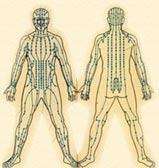| Gout is a metabolic disorder which results in raised blood levels of uric acid and the formation of crystals of uric acid salts in the joints. Uric acid is a natural element which results from the normal break down of food and the building up of body tissues. The clinical presentation of gout includes frequent attacks of arthritis, joint deformities, kidney damage and urinary stones.
From a TCM viewpoint, the clinical features of gout, such as frequent attacks of swelling, redness, heat and pain in the joints, and improper movement of limbs, place gout in the category of "bi-syndrome." The ancient TCM classic Suwen (The Book of Plain Questions) states that "bi-syndrome is due to a combined attack of wind, cold and dampness evils." Attacks on the meridians in the superficial areas of the body such as the feet and hands by wind, cold and dampness evils lead to stagnation of vital energy (qi) and blood circulation. It is an obstructive disorder.
Traditional Chinese medicine holds that there is a distribution network for the fundamental substances like qi, blood and body fluid throughout the body. This network is called the Meridian System. It links organs, limbs, joints, bones, tendons, tissues and skin, and provides communication between the body's interior and exterior.
 |
| Meridian system of the body |
|